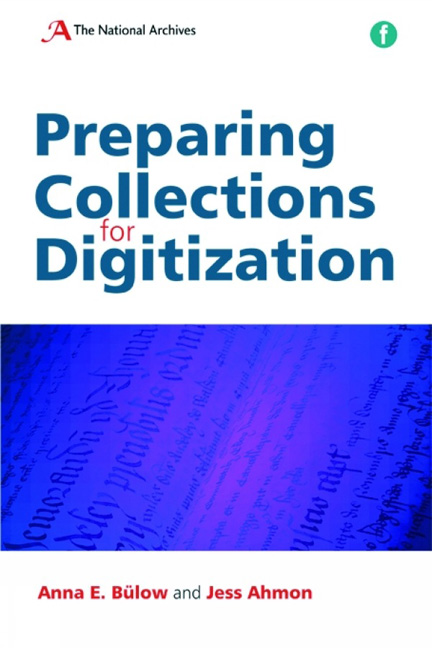Book contents
- Frontmatter
- Contents
- Acknowledgements
- List of figures and tables
- Introduction
- 1 Digitization in the context of collection management
- 2 Before you digitize: resources, suppliers and surrogates
- 3 The digital image Ross Spencer
- 4 The process of selection
- 5 Surveying collections
- 6 Equipment for image capture
- 7 Preparation of document formats and fastenings
- 8 Preparation of damaged documents
- 9 Setting up the imaging operation
- Conclusion
- Further reading
- Index
4 - The process of selection
Published online by Cambridge University Press: 08 June 2018
- Frontmatter
- Contents
- Acknowledgements
- List of figures and tables
- Introduction
- 1 Digitization in the context of collection management
- 2 Before you digitize: resources, suppliers and surrogates
- 3 The digital image Ross Spencer
- 4 The process of selection
- 5 Surveying collections
- 6 Equipment for image capture
- 7 Preparation of document formats and fastenings
- 8 Preparation of damaged documents
- 9 Setting up the imaging operation
- Conclusion
- Further reading
- Index
Summary
Introduction
Having addressed some of the fundamental issues at an institutional and technical level the next question to ask is ‘what should we digitize?’.Astute decisions at the selection stage will build a robust programme of digitization projects that enhance the value of an institute's holdings, broaden audience engagement and make a genuine contribution to the welfare and knowledge of a collection. Implementing a good selection policy also helps to ensure that projects are logistically feasible and adequately resourced, while selection that lacks focus or is ill-informed can result in a rambling succession of projects where the overall costs ultimately outweigh the benefits.
A strategy for digitization
For most institutions it is not feasible to digitize their entire collection. Since 2004, commercial partners have invested an estimated £53 million in The National Archives UK's digitization programme, delivering more than 80 million images online, but this only represents 3–5% of the entire collection (Morley, 2009). Even for a collection of thousands rather than millions of items the costs and logistics of digitization can be prohibitive. A process of selection is therefore needed to identify suitable collections.
Once collections are selected for digitization these need to be prioritized so as to develop a digitization programme. Aims and priorities vary between institutions and the objectives of a digitization programme should be in keeping with institutional goals, be that to preserve national treasures, utilize local history sources for education or develop partnerships with academic bodies. It may be appropriate for a digitization programme to be accompanied by a digitization strategy to explicitly state the aims and objectives of digitization.
Examples of digitization strategies
Digitization for access: The National Archives UK
Project Motorway, the digitization strategy of the National Archives UK, aims to make 90% of the archive's most popular documents available online. this is in response to increased user expectations to find, use and learn from online resources. the National Archives UK achieves its aims with the help of grant funding sources for content that is mainly of specialist interest and through teaming up with commercial partners for content that is more popular, such as documents of interest to the family history market. in addition, the archive funds some smaller projects internally (Ahmon, 2009).
- Type
- Chapter
- Information
- Preparing Collections for Digitization , pp. 47 - 62Publisher: FacetPrint publication year: 2010



